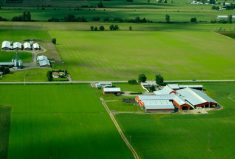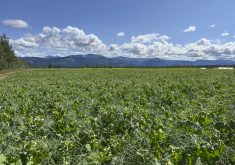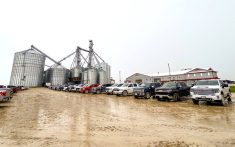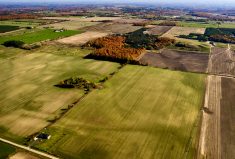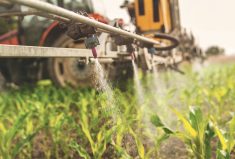Glacier FarmMedia – New data from Statistics Canada shows farm cash receipts continue to trend upward, increasing in 2019 by 5.7 per cent or $66.1 billion to mark the ninth consecutive year of increase and the largest single-year uptick since 2012.
But that number is less impressive when cannabis is removed from the equation, which represents 2.8 per cent of the total growth.
Without it, farm cash receipts increased by 2.9 per cent — only slightly higher than the 2.4 per cent average increase experienced in the past five years.
Why it matters: Farm income has a significant impact on the health of farm families and rural communities.
Read Also

Melancthon faces a new quarry fight over water, environment and farmland risks
A proposed Strada blast quarry in Melancthon, Ont., sparks regional debate over water protection, farmland sustainability, and Ontario’s aggregate policy.
“It’s still a positive story, but I would say it’s less positive,” said J.P Gervais, vice-president and chief agricultural economist for Farm Credit Canada.
Crop receipts totalled $36.6 billion over 2019, up 3.9 per cent. That too is largely due to a $1.7 billion increase in licensed cannabis producer receipts during the first full year of legalized recreational marijuana use. More than half of the growth in cannabis receipts, 56.5 per cent, came from Ontario and Alberta.
“Nobody knew the extent to the growth of cannabis. We knew that it was growing,” Gervais said.
Without cannabis factored in, crop revenues across the country actually declined 1.1 per cent.
Alberta saw the greatest gain in overall crop receipts ($1.3 billion) across the country, but gains were experienced in each province.
Durum wheat sales rose 22.5 per cent from 2018, in part due to production shortfalls elsewhere in the world leading to higher export demand for high quality Canadian durum.

Despite those increases, oilseed receipts moderated the overall rise in crop receipts, according to StatsCan. Canola producers’ revenue decreased 7.4 per cent in 2019 following a 6.5 decrease over 2018. The more recent decreases are largely due to Chinese import restrictions on canola seed.
Soybean receipts dropped 17.7 per cent, in part because of ample global supply and the ongoing United States-China trade dispute. According to StatsCanada, exports to China, Canada’s largest soybean export market, fell sharply after a record year in 2018 as importers there prioritized exports from other nations.
Livestock receipts went up 5.1 per cent over 2019, following a 0.1 per cent increase and hog revenue grew by 11.6 per cent, largely due to African swine fever impacting herd sizes elsewhere. Dairy receipts went up 5.1 per cent, and the supply managed commodities of chicken (4.7 per cent) and eggs (six per cent) also increased.
Producers received $3.1 billion from government payments, up 40.6 per cent from 2018. Nearly one-third of those payments were compensation to the dairy industry stemming from trade deals.
Operating expenses on farms went up in 2019 5.7 per cent to $53.1 billion. Half of that is due to increased cannabis production, but the cost of wages, fertilizer and interest expenses all went up too.
“We’ve been stagnant in terms of overall cash receipts, and yet overall expenses have continued to grow, so that’s what is to be monitored,” Gervais said, later adding, “Businesses are under a lot of pressure to maximize their production and it’s hard for them to cut back on inputs, especially when they know it’s going to have a positive return on their output.”
Realized net income of Canadian agricultural producers went up 10.4 per cent in 2019, reaching $4.9 billion. The increase is largely due to higher cannabis and livestock receipts, as well as an increase in program payments used to offset rising operating expenses.
According to StatsCan’s definition, realized net income is the difference between a farmer’s cash receipts and operating expenses, minus depreciation, plus income in kind.
The nationwide increase follows a 37.4 per cent decrease experienced in 2018, when high input costs and low canola receipts contributed to lower incomes.
While increases were recorded in 2019 in Alberta ($425 million), Quebec ($373 million), British Columbia ($102 million), New Brunswick ($41 million) and Prince Edward Island ($20 million), the two provinces representing a significant portion of Canada’s production saw decreases.
Saskatchewan farmers saw their overall income drop $311 million and their neighbours in Manitoba experienced a $179 million decrease. According to StatsCan, those figures are lower due to smaller increases in cannabis and oilseed receipts.
“We knew there were some production challenges in the Prairies, we knew there were challenges with harvest,” Gervais said, explaining the decline.
What isn’t known yet is the impact COVID-19 will have on 2020 figures. Reports from the first three months of the year show farm cash receipts went up 5.5 per cent compared to the same period last year to total $16.9 billion, with every province but Manitoba, Saskatchewan, and Newfoundland and Labrador showing increases.
But again cannabis played a huge role: without it factored in, crop receipts dropped 4.7 per cent.
Any figures released, including those showing higher livestock, hog and dairy receipts, should be considered with caution, considering the yet-to-be-determined impacts of the pandemic.






